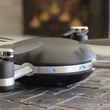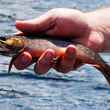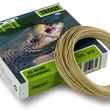Continuing our burgeoning series on underwater fishing photography, we're going to take a look the gear available for those of you looking to take your fishing photography below the surface. From inexpensive technology that you might already have, to mid range investments to professional underwater rigs, there's a bevy of options out there that will allow almost anyone looking to enter the world of underwater photography to get wet.

Smartphones
Thanks to third party case manufacturers, smartphones have long been underwater ready. Over the last few years, smartphone cameras have grown in leaps and bounds in their ability to capture quality images -- giving fishing photographers an increasingly compelling reason to start taking their smartphones under the waves. The far and away standouts amongst waterproof cases are the Lifeproof fre and Lifeproof nuud. Using the iPhone as example, the nuud (not yet available for the iPhone 6) currently retails for $49 (via Amazon) and the fre goes for $79 (via Amazon). And these cases won't only protect your smartphone from the water, they'll make it all-around more field ready by making it dust and dirt proof and adding drop protection (from up to 6 feet).

Even more recently, waterproof smartphones have been hitting the market -- no case required. Phones like the Sony Xperia Z3 and Z2, Samsung Galaxy S5 and S4 and Kyocera Brigadier offer IP (Ingress Protection) ratings that certify them as resistant to water for up to 30 minutes at depths less than 3 feet. While these ratings may be unimpressive to divers looking to snap underwater photos as a result of their depth limits, the 3 foot limit places little restriction on the underwater fishing photographer, who spends the vast majority of his or her time snapping shots near or just below the surface. The aforementioned Lifeproof nuud and fre cases have an IP rating of IP68, which rates them to be a bit more hardy, resisting water intrusion down to 6.6 feet (2 meters) for up to an hour.

The most attractive aspect of adopting a smartphone as your underwater photography tool is undoubtedly the price. For many, this may mean no additional investment whatsoever, while for others $50 may be all that is required to head beneath the surface with a very capable picture taking machine. It is, unquestionably, the most affordable way to get started snapping underwater shots.
Waterproof Cameras
Waterproof point-and-shoot cameras have also been readily available for some time and typically offer better image quality than smartphones, despite how much smartphone cameras have advanced over the last few years. They also offer greater control and more versatility, especially in regards to the photographers ability to quickly grab their waterproof camera and start shooting. With smartphones, the user must wake the phone, enter its camera app and use a device who's ergonomics aren't tuned primarily to facilitate picture taking. Despite how thoughtful manufacturers have been with increasing how picture-taking friendly their smartphones are, point-and-shoot cameras still have a significant edge in this department.

Like smartphones, point-and-shoot waterproof cameras represent one of the least expensive ways to enter the world of underwater fishing photography. Even the best in class Olympus Tough TG-3 can be had for less than $400 ($369 via Amazon) and other capable options such as the Panasonic Lumix DMC-TS5 come even cheaper ($342 via Amazon). Both the Tough TG-3 and the Lumix DMC-TS5 are capable picture taking machines that will produce quality images both above and below the water's surface, and both have video capabilities as well.
The GoPro
These days, the GoPro may in fact be the first camera that comes to mind when most people think of underwater photography. That's saying something about a brand that didn't even exist a little over a decade ago. The GoPro's case (standard with all GoPro models) unquestionably makes the GoPro a rugged, underwater picture taking machine, rated to be waterproof up to a whopping 197 feet (60 meters). The GoPro is well known for its stunning video capture capabilities, but also doubles as a still camera -- the new Hero 4 Black can shoot 12 megapixel stills at up a blazing 30 frames per second.

It's worth noting that the GoPro's wide angle lens limits its versatility as a still photo producer. Again, however, anglers win out here, thanks to the fact that the fishing photographer typically spends most of his or her time working up close -- limiting the drawbacks of the GoPro's wide angle lens. It's also important to mention that the GoPro's lens, with a focal length range of 14-28mm, at its narrowest isn't significantly different from the lenses found in most smartphones (29mm for the iPhone 6, for instance).
At under $500 for its flagship Hero 4 Black ($499 for the starter bundle at no extra cost via Amazon), the GoPro is another option for joining the underwater world of photography without digging too deep into your pocketbook.
Waterproof Cases for Compact Cameras
Photographers that value image quality and the ability to manually control the picture taking process, but that aren't looking to drop several thousand dollars into an underwater rig, typically look beyond the aforementioned snap-and-go options and into the world of compact enthusiast cameras. This is the universe of cameras like the Canon Powershot G1 X Mark II, Nikon Coolpix 7800, Fujifilm X30, and Olympus Stylus 1, amongst others. While none of these cameras are waterproof out of the box, much like smartphones, waterproof cases are readily available for these models.

Using the Canon Powershot G1 X Mark II ($799 via Amazon) as an example, these cases may be made by the manufacturer ($268 via Amazon) or may be third part cases from companies like Ikelite ($749 via Amazon). While either case will render these enthusiast compacts hardy, waterproof implements, they offer different feature sets -- as suggested by the significant difference in price. Most notable amongst these feature sets is the ability to change the lens port on the front of the housing, which adds picture taking versatility by changing the way that the camera interacts with the underwater world. Third party cases may also offer a higher depth rating, although this is unlikely of little interest to the fishing photographer.
DSLR Camera Housings
Waterproof housings for DSLRs are the territory of professionals and serious hobbyists, but they also offer far and away the greatest versatility and image quality, thanks primarily to the cameras which they house. Whether occupied by a more modestly priced cropped-sensor DSLR such as Canon's 7D Mark II or a the ubiquitous full-frame 5D Mark III, the cameras found inside DSLR housings from companies like Aquatech remain unmatched in their ability to produce vibrant, detailed images. Perhaps more importantly, they provide a level of control of the image capture process that is invaluable to the professional or advanced amateur photographer. If you're looking to enter the world of underwater fishing photography at the top, look no further.

Like third party housings for enthusiast compacts, DSLR housings offer interchangeable ports. This is particularly important in the world of DSLRs, which feature interchangeable lenses. The ability of underwater DSLR housings to be fit with different lens ports allows the photographer to utilize different lenses -- whether wide angle, telephoto, or speciality lenses such as fisheyes -- with their cameras. The result is a toolset that -- unlike any of the other available options -- gives the photographer total creative control over underwater image capture.
The downside of underwater DSLR housings is their cost. Housings typically start around $1,500 and some models can reach upwards of $3,000. Extension tubes (ranging roughly from $100-$300) and lens ports (anywhere from $200 to $1,000) quickly add to the tally.
That said, a very versatile setup for many an underwater fishing photographer can be had by assembling a rig that includes a housing and an 8" dome port (plus an extension tube, if required by the lens(es) you plan to use most often). The rig will also be one you can grow iteratively, adding lens ports and other accessories as you go.
As our series continues, we'll focus mainly on the world of underwater fishing photography through the use of DSLR camera housings such as the Aquatech Elite series ($1899 via Adorama). But, stick with us even if you're not ready to make the leap into the world of DSLRs and underwater housings as many of the tips and techniques we'll cover will also apply to the world of underwater photography as a whole.
Underwater Fishing Photography Series
Underwater Fishing Photography: An Introduction
Underwater Fishing Photography: The Gear
Underwater Fishing Photography: Tips for Success
Underwater Fishing Photography: Mastering the Split Shot (coming soon)

































Comments